Pitrie does good work in collating certain important and significant feminine images from the Old Testament. These are: Mary as the ark of the covenant, the new Eve, the new Rachel and a theological concept that was new to me, Mary as the queen mother, the mother of the king. We also get a thoughtful investigation of the woman in the book of Revelations [Apocalypse in Catholic usage.]
Some of these themes are well-known. Christians have long thought Jesus the second Adam, who reverses the effects of the primal fall in which Adam sinned. Mary is seen as the new Eve, whose obedience to God at the incarnation reverses Eve's disobedience. He uses the concept of Mary as the new Eve to justify the Catholic claim that Mary was sinless, for he claims that if the old Adam and Eve were sinners, the new Adam [Jesus] and by implication Mary would have to be sinless. But the sinlessness of Mary would be impossible to prove.
Mary as the ark of the covenant, the bearer of God's presence, is a point about which I have written before, and it is a well-known Scriptural theme grounded in Luke's infancy account of the visitation, but a Scriptural point that was new to me was Mary as the queen mother. Pitrie reveals that in ancient Israel the queen and second to the king was not the king's wife [which one anyway?] but the king's mother, who had a special right of intercession with the king. That the king's mother had a special role in the old Israel would, Pitrie believes, lead Christians to think that in the New Israel, the church, there would be a role for a queen mother who would enjoy a special place as an intercessor with Christ, and this would be Mary. It is very clear that Pitrie is on strong ground in locating the foundations of the Christian cult of Mary in Judaism. That paganism had a an influence on the adoption of the Marian cultus should not be taken as grounds for thinking it a pagan intrusion, but as a legitimate confluence of two streams of thought, which allowed the sacred feminine to achieve its due recognition in the Christian church.
Pitrie extends his analysis of the sacred feminine represented by Mary to the concept of Mary as the new Rachel. Rachel, beloved wife of Jacob, is known as the mother of Israel. Though she is dead the prophet Jeremiah depicts her mourning for her suffering children as they go into exile. Mary, who mourned her son at the foot of the cross, is representative of Rachel in the new community of Israel, the church.
The author does a good job of showing how in the life of Mary significant Old Testament themes converge, just as they do in Jesus. Mary is therefore not an unnecessary addition to the life of the Christian church, but an element integral to the sacred drama that is played out in the life of Christ.










 The North Wales Pilgrim Path29 days ago
The North Wales Pilgrim Path29 days ago
 Rewilding the Isle of the Thundergodon 02/17/2024
Rewilding the Isle of the Thundergodon 02/17/2024
 Adrienne von Speyr a life on the edge of heavenon 01/24/2024
Adrienne von Speyr a life on the edge of heavenon 01/24/2024
 The Granite Kingdom: a Cornish Journeyon 12/29/2023
The Granite Kingdom: a Cornish Journeyon 12/29/2023



Comments
I suspect that the latter possibility was the dominant motive.
The first paragraph to the first subheading, The Motivation of the Book, alerts us to the facts that "Pitrie's motivation in writing this book was generally to support and promote Catholic teaching, but his motives are rooted in an incident in his personal history. When preparing for marriage he had to attend some meetings with his Baptist wife-to-be's pastor, which was supposed to be marriage preparation."
Were the meetings so that two faiths would work harmoniously after the marriage or were they because one engaged person was going to convert to the other engaged person's faith?
Good work.
A young lady who is a branch-library assistant has the name Maryam. Her family background may be a Catholic combination of Indian (Goan?) and Middle Eastern (Iraq? Lebanon? Palestine?).
Maryam said that her name meant "Mary mother of Our Lord Jesus." She then said when I asked her what Mary literally meant that she remembers as a very young child her grandparents telling her it meant beloved!
Joseph belonged to the family of David, who had lands around Bethlehem, and it is significant that Bethlehem was the town to which Joseph was returning when people were told to register in their own towns. It is also significant that Joseph decided not to settle in Bethlehem simply because the cruel Archelaus had taken the throne of Judea from his late father, implying that he had originally intended to settle in Bethlehem. The Orthodox Church has a tradition that Joseph's first wife was called Salome.
The meaning of the name Mary is unclear, but beloved is the option most likely for a girl's name.
Revisiting your wizzley brought to mind a couple of questions I'd meant to ask with the first reading and the second and now the third re-readings.
Does anyone anywhere say anything about where Joseph lived with a possible first wife and who she was?
And what is the meaning of Mary's name? Our Lady Mary is special so I particularly like where you say "I was pleased that when dealing with the issue of Mary's assumption into heaven he argues that her assumption was a physical resurrection, just as Jesus was resurrected."
And yet her name etymologically has been linked -- according to Wiktionary -- with the Hebrew roots מ־ר־ר (m-r-r, "to be bitter") and מ־ר־י (m-r-y, "to mutiny, rebellion, disobedience"). Wiktionary also mentions the Egyptian mry ("beloved") as a possibility which I quite like.
My first encounter with this issue was when a priest said that the word for brothers in the gospel text was phratres,which can be taken as cousins.When I checked my Greek New Testament I found that he spoke falsely,for the word was adelphoi, which denotes brothers,though usage might be loose. When I checked against the story of the visitation, when Mary visited her cousin Elizabeth, I found that the word for cousin is syngeneis,which means from the same clan. There is a clear distinction between brother and cousin. But many cultures do not make a distinction between brother and half brother, so if Joseph was a widower, as John of Damascus says, Jesus' brothers could have been his half brothers.
I have never found any evidence that cousins might be classed as brothers, and considering that there was a word for cousin that I have already mentioned such a word was not needed.
Jennifer, you are exactly and completely right.
frankbeswick, Thank you for the backstories and products. Have you come across information to the effect that at the time of Our Lady Mary it was common to refer to first cousins as brothers and sisters?
Enjoyed your review - if I come across the book I will look into it! Very true that a strong personal faith provides a good foundation for writing about such matters, which are matters of faith. Otherwise theology really does just become the scholar's critical analysis of what theologians think God might be all about. A scholar with faith allows God in!